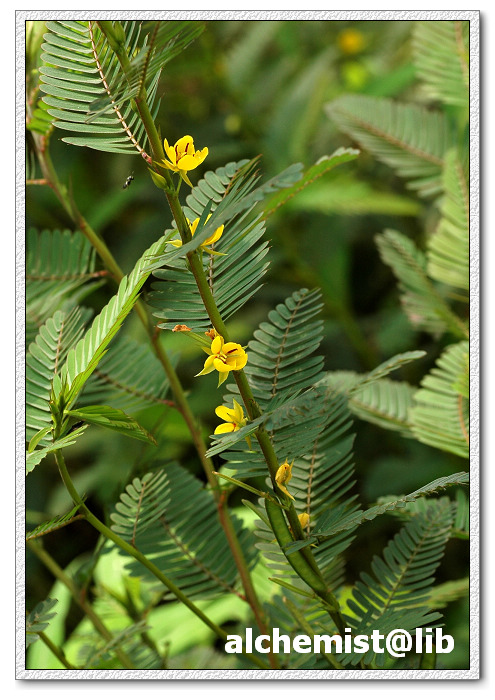
- Scientific Name: Mimosa bimucronata (DC.) Kuntze
- Ref: Revis. Gen. Pl. 1:198. 1891
- Synonyms: Acacia bimucronata DC.; Mimosa sepiaria Benth.; M. stuhlmannii Harms; M. thyrsoidea Griseb.
- Chinese Common Name: 光荚含羞草 guāngjiá hánxiū∙cǎo, 含羞草决明 hánxiū∙cǎo juémíng
- Family: Fabaceae
- Genus: Mimosa
- Distribution: Introduced in Guangdong, escaped in thin forests [native to South America (NE Argentina and E Brazil)].
- Photo: 06/21/2009, South China Botanical Garden, Guangdong
Shrubs, deciduous, 3-6 m tall. Branchlets unarmed in distal parts, in lower parts armed by recurved prickles to 1 cm, densely yellow tomentose. Pinnae 4-9 pairs, 1.5-8 cm; rachis unarmed, pubescent; leaflets 12-16 pairs, linear, 5-7 × 1-1.5 mm, leathery, glabrous to puberulent with ciliate margin, main vein near upper side, apex mucronate. Heads globose, forming a spreading panicle with compound, spreading lower branches. Flowers white, scented. Calyx cup-shaped, minute. Petals oblong, 2.5-4 mm, connate at base. Stamens 8; filaments 4-5 mm. Ovary initially glabrous. Legume brown, straight, strap-shaped, 3.5-4.5 × ca. 0.6 cm, unarmed, finely reticulate veined, usually with 4-8 segments. Seeds olivaceous, ovoid, compressed, ca. 4.5 mm. 2n = 26*. (Flora of China)
